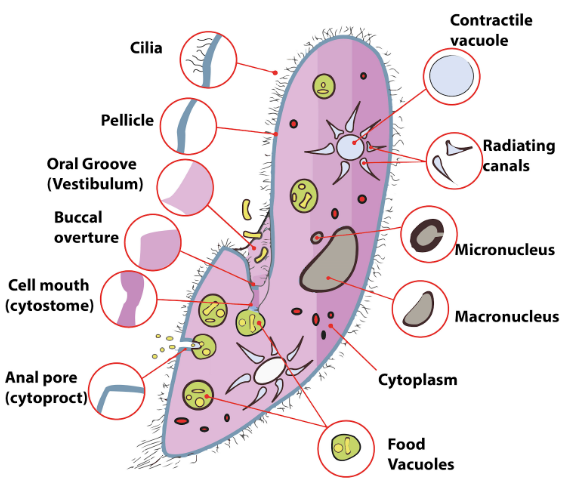
How do Paramecium satisfy the characteristics of living things?
Answer
431.7k+ views
Hint: Living beings have particular characteristics that separate from non-living creatures. The paramecium is a living being, hence it satisfies all the characteristics mentioned above. You must elaborate on how the organism carries out, growth, reproduction, locomotion, etc.
Complete answer:
- The Paramecium is a single-celled and free-living protozoan that inhabits aquatic habitats.
- Living beings have a set of characteristics that Paramecium fulfills. They are as follows.
1. All living beings reproduce. Paramecium reproduces by asexual binary fission where a fully grown microorganism divides into two daughter cells. They also reproduce sexually through conjugation or autogamy.
2. Living beings excrete waste material formed from metabolic processes. Food waste is formed in contractile vacuole and is excreted through the anus.
3. Living beings need nutrition for their survival. Paramecium mainly feeds on bacteria but also ingest yeast, algae and some non-living substances like starch, milk powder, etc. They are equipped with a mouth to ingest food which gets digested in the gullet where the food particles are converted in food vacuoles. After the digestion of this food, the waste gets removed from the anus.
4. Living beings have some form of locomotion or movement. The bodies of paramecium are covered in cilia, short hairy protrusions that help in the movement of the cell. The structures whip back and forth and help to propel the organism.
5. Living beings have some mechanism of breathing or respiration of gases. Paramecium breathes in through its cell membrane by diffusion of gases.
6. Living things have sensitivity to stimuli. Paramecia respond to various environmental stimuli and react accordingly.
7. Living beings display some form of physical growth. After binary fission, paramecia grow in size through various metabolic processes and also increase in size to undergo fission themselves to form daughter cells.
Note:
- Paramecia have two kinds of nuclei - the micronucleus and the macronucleus.
- The organism also undergoes cytogamy, another type of self-fertilization, where two organisms join together but do not undergo nuclear exchange.
- According to JD Forney, all Paramecium species have one macronucleus but the number of micronuclei can vary by species.

Complete answer:
- The Paramecium is a single-celled and free-living protozoan that inhabits aquatic habitats.
- Living beings have a set of characteristics that Paramecium fulfills. They are as follows.
1. All living beings reproduce. Paramecium reproduces by asexual binary fission where a fully grown microorganism divides into two daughter cells. They also reproduce sexually through conjugation or autogamy.
2. Living beings excrete waste material formed from metabolic processes. Food waste is formed in contractile vacuole and is excreted through the anus.
3. Living beings need nutrition for their survival. Paramecium mainly feeds on bacteria but also ingest yeast, algae and some non-living substances like starch, milk powder, etc. They are equipped with a mouth to ingest food which gets digested in the gullet where the food particles are converted in food vacuoles. After the digestion of this food, the waste gets removed from the anus.
4. Living beings have some form of locomotion or movement. The bodies of paramecium are covered in cilia, short hairy protrusions that help in the movement of the cell. The structures whip back and forth and help to propel the organism.
5. Living beings have some mechanism of breathing or respiration of gases. Paramecium breathes in through its cell membrane by diffusion of gases.
6. Living things have sensitivity to stimuli. Paramecia respond to various environmental stimuli and react accordingly.
7. Living beings display some form of physical growth. After binary fission, paramecia grow in size through various metabolic processes and also increase in size to undergo fission themselves to form daughter cells.
Note:
- Paramecia have two kinds of nuclei - the micronucleus and the macronucleus.
- The organism also undergoes cytogamy, another type of self-fertilization, where two organisms join together but do not undergo nuclear exchange.
- According to JD Forney, all Paramecium species have one macronucleus but the number of micronuclei can vary by species.

Recently Updated Pages
Master Class 11 Accountancy: Engaging Questions & Answers for Success

Glucose when reduced with HI and red Phosphorus gives class 11 chemistry CBSE

The highest possible oxidation states of Uranium and class 11 chemistry CBSE

Find the value of x if the mode of the following data class 11 maths CBSE

Which of the following can be used in the Friedel Crafts class 11 chemistry CBSE

A sphere of mass 40 kg is attracted by a second sphere class 11 physics CBSE

Trending doubts
10 examples of friction in our daily life

Difference Between Prokaryotic Cells and Eukaryotic Cells

One Metric ton is equal to kg A 10000 B 1000 C 100 class 11 physics CBSE

State and prove Bernoullis theorem class 11 physics CBSE

What organs are located on the left side of your body class 11 biology CBSE

Define least count of vernier callipers How do you class 11 physics CBSE




